Post-Fire Changes in Canopy Solute Leaching in Pinus densiflora Forests
Abstract
:1. Introduction
2. Materials and Methods
2.1. Study Site
2.2. Field Measurement Setup
2.3. Statistical Analysis
3. Results
3.1. Stand Structure
3.2. Throughfalll
3.3. TOC and Calcium in Throughfall
4. Discussion
5. Conclusions
Author Contributions
Funding
Data Availability Statement
Conflicts of Interest
References
- Levia, D.F.; Keim, R.F.; Carlyle-Moses, D.E.; Frost, E.E. Throughfall and stemflow in wooded ecosystems. For. Hydrol. Biogeochem. Synth. Past Res. Future Dir. 2011, 216, 425–443. [Google Scholar]
- Levia, D.F., Jr.; Frost, E.E. A review and evaluation of stemflow literature in the hydrologic and biogeochemical cycles of forested and agricultural ecosystems. J. Hydrol. 2003, 274, 1–29. [Google Scholar] [CrossRef]
- Levia, D.F., Jr.; Frost, E.E. Variability of throughfall volume and solute inputs in wooded ecosystems. Prog. Phys. Geogr. 2006, 30, 605–632. [Google Scholar] [CrossRef]
- Parker, G. Throughfall and stemflow in the forest nutrient cycle. Adv. Ecol. Res. 1983, 13, 57–133. [Google Scholar]
- Li, Y.; Alva, A.; Calvert, D.; Zhang, M. Chemical composition of throughfall and stemflow from citrus canopies. J. Plant Nutr. 1997, 20, 1351–1360. [Google Scholar] [CrossRef]
- Lee, S.-D.; Lee, M.; Joo, Y. The Chemical Properties of Stemflow and Throughfall on Pinus densiflora and Pinus rigida. Korean Soc. Agric. For. Meteorol. 2001, 17, 141–148. [Google Scholar]
- Staelens, J.; De Schrijver, A.; Verheyen, K.; Verhoest, N.E. Spatial variability and temporal stability of throughfall water under a dominant beech (Fagus sylvatica L.) tree in relationship to canopy cover. J. Hydrol. 2006, 330, 651–662. [Google Scholar] [CrossRef]
- Neary, D.G.; Ryan, K.C.; DeBano, L.F. Wildland Fire in Ecosystems: Effects of Fire on Soils and Water; United States Department of Agriculture, Forest Service, Rocky Mountain Research Station: Ogden, UT, USA, 2005; Volume 42, pp. 95–118. [Google Scholar]
- Wade, D.; Johansen, R. Effects of fire on southern pine: Observations and recommendations. USDA Forest Service, Southeastern Forest Experiment Station. Gen. Tech. Rep. SE 1986, 41, 1–14. [Google Scholar]
- Vega, J.; Fernández, C.; Fonturbel, T. Throughfall, runoff and soil erosion after prescribed burning in gorse shrubland in Galicia (NW Spain). Land Degrad. Dev. 2005, 16, 37–51. [Google Scholar] [CrossRef]
- Corbin, T.A. Short-term effects of a wildfire on the water quality and macroinvertebrate community of a saline stream. Int. J. Wildland Fire 2012, 21, 537–544. [Google Scholar] [CrossRef]
- Murphy, B.F.; Ye, H.; Delage, F. Impacts of variations in the strength and structure of El Niño events on Pacific rainfall in CMIP5 models. Clim. Dyn. 2015, 44, 3171–3186. [Google Scholar] [CrossRef]
- White, A. Examining the Impacts of Wildfire on Throughfall and Stemflow Chemistry and Flux at Plot and Catchment Scales; The University of Arizona: Tempe, AZ, USA, 2015. [Google Scholar]
- Kelly, R.; Montgomery, W.I.; Reid, N. Differences in soil chemistry remain following wildfires on temperate heath and blanket bog sites of conservation concern. Geoderma 2018, 315, 20–26. [Google Scholar] [CrossRef]
- Crouch, R.L.; Timmenga, H.J.; Barber, T.R.; Fuchsman, P.C. Post-fire surface water quality: Comparison of fire retardant versus wildfire-related effects. Chemosphere 2006, 62, 874–889. [Google Scholar] [CrossRef] [PubMed]
- Gómez-Rey, M.X.; González-Prieto, S.J. Short and medium-term effects of a wildfire and two emergency stabilization treatments on the availability of macronutrients and trace elements in topsoil. Sci. Total Environ. 2014, 493, 251–261. [Google Scholar] [CrossRef] [PubMed]
- Certini, G.; Nocentini, C.; Knicker, H.; Arfaioli, P.; Rumpel, C. Wildfire effects on soil organic matter quantity and quality in two fire-prone Mediterranean pine forests. Geoderma 2011, 167, 148–155. [Google Scholar] [CrossRef]
- Onodera, S.-I.; Van Stan, J.T. Effect of forest fires on hydrology and biogeochemistry of watersheds. For. Hydrol. Biogeochem. Synth. Past Res. Future Dir. 2011, 216, 599–621. [Google Scholar]
- Jackson, B.; Miller, W. Soil Solution Chemistry of a Fly Ash-, Poultry Litter-, and Sewage Sludge-Amended Soil; 0047-2425; Wiley Online Library: New York, NY, USA, 2000. [Google Scholar]
- Chorover, J.; Vitousek, P.M.; Everson, D.A.; Esperanza, A.M.; Turner, D. Solution chemistry profiles of mixed-conifer forests before and after fire. Biogeochemistry 1994, 26, 115–144. [Google Scholar] [CrossRef]
- Abney, R.B.; Berhe, A.A. Pyrogenic carbon erosion: Implications for stock and persistence of pyrogenic carbon in soil. Front. Earth Sci. 2018, 6, 26. [Google Scholar] [CrossRef]
- Ranalli, A.J. A Summary of the Scientific Literature on the Effects of Fire on the Concentration of Nutrients in Surface Waters; US Geological Survey Reston: Reston, VA, USA, 2004. [Google Scholar]
- Hohner, A.K.; Rhoades, C.C.; Wilkerson, P.; Rosario-Ortiz, F.L. Wildfires alter forest watersheds and threaten drinking water quality. Acc. Chem. Res. 2019, 52, 1234–1244. [Google Scholar] [CrossRef]
- Davidson, S.J.; Elmes, M.C.; Rogers, H.; van Beest, C.; Petrone, R.; Price, J.S.; Strack, M. Hydrogeologic setting overrides any influence of wildfire on pore water dissolved organic carbon concentration and quality at a boreal fen. Ecohydrology 2019, 12, e2141. [Google Scholar] [CrossRef]
- Su, L.; Yang, J.; Zhao, X.; Miao, Y. Effects of fire on interception loss in a coniferous and broadleaved mixed forest. J. Hydrol. 2022, 613, 128425. [Google Scholar] [CrossRef]
- Leu, S.-S.; Bui, Q.-N. Leak prediction model for water distribution networks created using a Bayesian network learning approach. Water Resour. Manag. 2016, 30, 2719–2733. [Google Scholar] [CrossRef]
- Muzylo, A.; Llorens, P.; Valente, F.; Keizer, J.; Domingo, F.; Gash, J. A review of rainfall interception modelling. J. Hydrol. 2009, 370, 191–206. [Google Scholar] [CrossRef]
- Dunkerley, D. Measuring interception loss and canopy storage in dryland vegetation: A brief review and evaluation of available research strategies. Hydrol. Process. 2000, 14, 669–678. [Google Scholar] [CrossRef]
- Korea Meteorological Administration. Available online: https://data.kma.go.kr (accessed on 13 February 2023).
- Li, Q.; Ahn, S.; Kim, T.; Im, S. Post-fire impacts of vegetation burning on soil properties and water repellency in a pine forest, South Korea. Forests 2021, 12, 708. [Google Scholar] [CrossRef]
- Korean Standards & Certification. Solid Mineral Fuels—Determination of Carbon and Hydrogen Sulfur—High Temperature Combustion Method; KS E ISO609; Korean Standards & Certification: Eumseong, Republic of Korea, 2003. [Google Scholar]
- Korean Standards & Certification. Water Quality—Determination of Selected Elements by Inductively Coupled Plasma Optical Emission Spectrometry (ICP-OES); KS I ISO11885; Korean Standards & Certification: Eumseong, Republic of Korea, 2018. [Google Scholar]
- Trinh, D.H.; Chui, T.F.M. An empirical method for approximating canopy throughfall. Hydrol. Process. 2013, 27, 1764–1772. [Google Scholar] [CrossRef]
- Frazer, G.W.; Canham, C.D.; Lertzman, K.P. Gap Light Analyzer (GLA), Version 2.0: Imaging software to extract canopy structure and gap light transmission indices from true-colour fisheye photographs, users manual and program documentation. Simon Fraser Univ. Burnaby Br. Columbia Inst. Ecosyst. Stud. Millbrook N. Y. 1999, 36, 1–40. [Google Scholar]
- R Core Team. R: A Language and Environment for Statistical Computing; R Foundation for Statistical Computing: Vienna, Austria, 2023; Available online: https://www.R-project.org/ (accessed on 17 March 2023).
- Clarke, P.J.; Lawes, M.; Midgley, J.J.; Lamont, B.; Ojeda, F.; Burrows, G.; Enright, N.; Knox, K. Resprouting as a key functional trait: How buds, protection and resources drive persistence after fire. New Phytol. 2013, 197, 19–35. [Google Scholar] [CrossRef]
- Nadkarni, N.M.; Sumera, M.M. Old-growth forest canopy structure and its relationship to throughfall interception. For. Sci. 2004, 50, 290–298. [Google Scholar]
- Williams, C.; Silins, U.; Wagner, M.J.; Bladon, K.D.; Martens, A.M.; Anderson, A.; Stone, M.; Emelko, M.B. Impacts of Wildfire on Interception Losses and Net Precipitation in a Sub-Alpine Rocky Mountain Watershed in Alberta, Canada; AGU Fall Meeting Abstracts: San Francisco, CA, USA, 2014. [Google Scholar]
- Gilliam, F.S.; Seastedt, T.R.; Knapp, A.K. Canopy rainfall interception and throughfall in burned and unburned tallgrass prairie. Southwest. Nat. 1987, 32, 267–271. [Google Scholar] [CrossRef]
- Crockford, R.; Richardson, D. Partitioning of rainfall into throughfall, stemflow and interception: Effect of forest type, ground cover and climate. Hydrol. Process. 2000, 14, 2903–2920. [Google Scholar] [CrossRef]
- Levia, D.F.; Hudson, S.A.; Llorens, P.; Nanko, K. Throughfall drop size distributions: A review and prospectus for future research. Wiley Interdiscip. Rev. Water 2017, 4, e1225. [Google Scholar] [CrossRef]
- Aston, A.R. Rainfall interception by eight small trees. J. Hydrol. 1979, 42, 383–396. [Google Scholar] [CrossRef]
- Van Stan, J.T.; Wagner, S.; Guillemette, F.; Whitetree, A.; Lewis, J.; Silva, L.; Stubbins, A. Temporal dynamics in the concentration, flux, and optical properties of tree-derived dissolved organic matter in an epiphyte-laden oak-cedar forest. J. Geophys. Res. Biogeosci. 2017, 122, 2982–2997. [Google Scholar] [CrossRef]
- Wagner, S.; Brantley, S.; Stuber, S.; Van Stan, J.; Whitetree, A.; Stubbins, A. Dissolved black carbon in throughfall and stemflow in a fire-managed longleaf pine woodland. Biogeochemistry 2019, 146, 191–207. [Google Scholar] [CrossRef]
- Cakmak, S.; Dales, R.E.; Vida, C.B. Components of particulate air pollution and mortality in Chile. Int. J. Occup. Environ. Health 2009, 15, 152–158. [Google Scholar] [CrossRef]
- Han, H. The Sources and Fates of Dissolved Organic Carbon in Aerosols and Seawater Revealed by Its Isotopes and Optical Characteristics; Seoul National University: Seoul, Republic of Korea, 2021. [Google Scholar]
- Pio, C.; Legrand, M.; Alves, C.; Oliveira, T.; Afonso, J.; Caseiro, A.; Puxbaum, H.; Sánchez-Ochoa, A.; Gelencsér, A. Chemical composition of atmospheric aerosols during the 2003 summer intense forest fire period. Atmos. Environ. 2008, 42, 7530–7543. [Google Scholar] [CrossRef]
- Jeong, S.; Otsuki, K.; Farahnak, M. Relationship between stand structures and rainfall partitioning in dense unmanaged Japanese cypress plantations. J. Agric. Meteorol. 2019, 75, 92–102. [Google Scholar] [CrossRef]
- Suzuki, S.; Yoshitake, T.; Goto, Y. Estimation of wind load on trees in forest. Kanto J. For. Res. 2010, 61, 215–218. [Google Scholar]
- Li, Q.; Lee, Y.E.; Im, S. Characterizing the interception capacity of floor litter with rainfall simulation experiments. Water 2020, 12, 3145. [Google Scholar] [CrossRef]
- Iida, S.I.; Tanaka, T.; Sugita, M. Change of interception process due to the succession from Japanese red pine to evergreen oak. J. Hydrol. 2005, 315, 154–166. [Google Scholar] [CrossRef]
- Nanko, K.; Hotta, N.; Suzuki, M. Evaluating the influence of canopy species and meteorological factors on throughfall drop size distribution. J. Hydrol. 2006, 329, 422–431. [Google Scholar] [CrossRef]
- Nanko, K.; Onda, Y.; Ito, A.; Moriwaki, H. Effect of canopy thickness and canopy saturation on the amount and kinetic energy of throughfall: An experimental approach. Geophys. Res. Lett. 2008, 35, 1–5. [Google Scholar] [CrossRef]
- Rosier, C.L.; Van Stan, J.T.; Moore, L.D.; Schrom, J.O.; Wu, T.; Reichard, J.S.; Kan, J. Forest canopy structural controls over throughfall affect soil microbial community structure in an epiphyte-laden maritime oak stand. Ecohydrology 2015, 8, 1459–1470. [Google Scholar] [CrossRef]
- Ryan, W. Variation in Stemflow Volume and Chemistry in Black Birch (Betula lenta L.) in Relation to Tree Size and Associated Bark Textural Changes; University of Delaware: Newark, NJ, USA, 2011. [Google Scholar]
- Levia, D.; Herwitz, S. Interspecific variation of bark water storage capacity of three deciduous tree species in relation to stemflow yield and solute flux to forest soils. Catena 2005, 64, 117–137. [Google Scholar] [CrossRef]
- Pérez-Suárez, M.; Fenn, M.; Cetina-Alcalá, V.; Aldrete, A. The effects of canopy cover on throughfall and soil chemistry in two forest sites in the México City air basin. Atmósfera 2008, 21, 83–100. [Google Scholar]
- Raison, R.; Khanna, P.; Woods, P. Transfer of elements to the atmosphere during low-intensity prescribed fires in three Australian subalpine eucalypt forests. Can. J. For. Res. 1985, 15, 657–664. [Google Scholar] [CrossRef]
- Blum, J.D.; Klaue, A.; Nezat, C.A.; Driscoll, C.T.; Johnson, C.E.; Siccama, T.G.; Eagar, C.; Fahey, T.J.; Likens, G.E. Mycorrhizal weathering of apatite as an important calcium source in base-poor forest ecosystems. Nature 2002, 417, 729–731. [Google Scholar] [CrossRef]
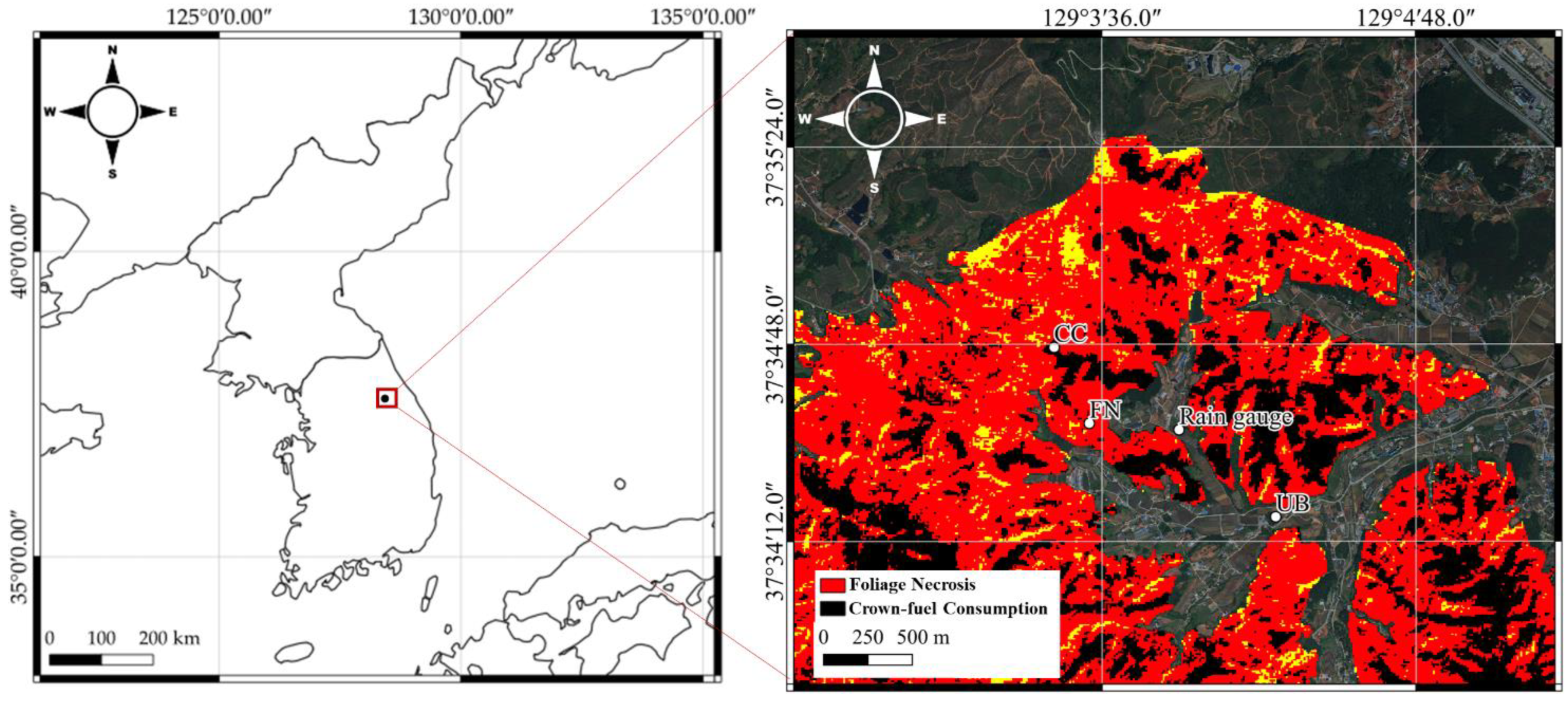
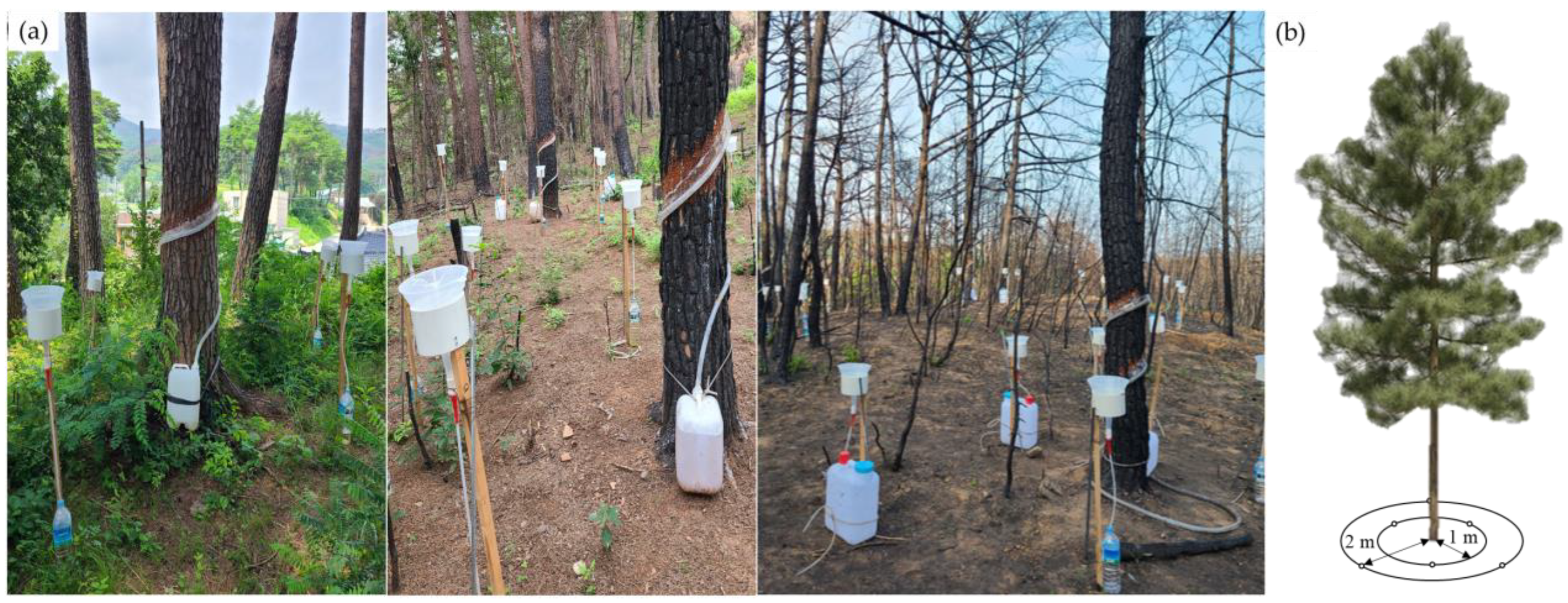
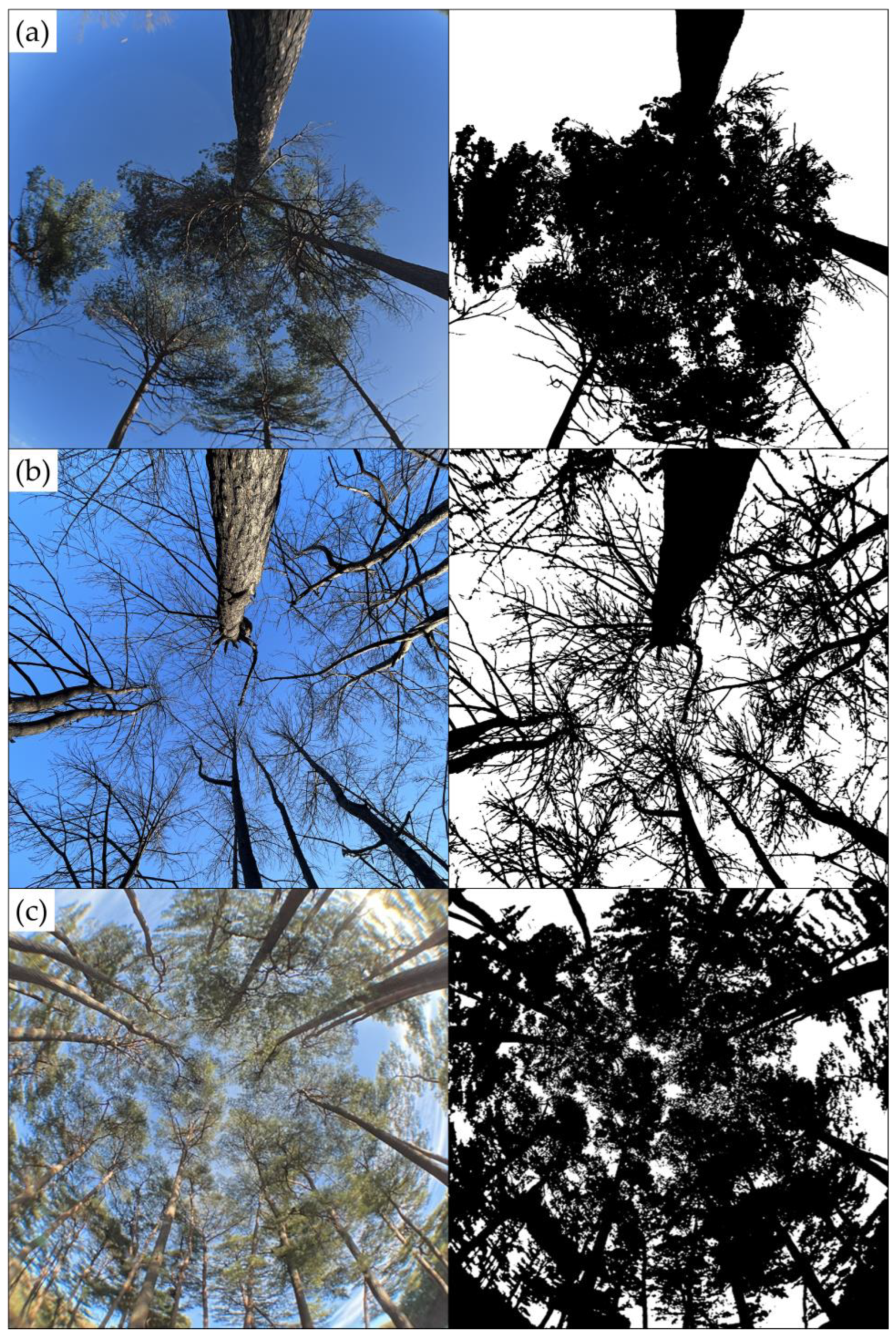
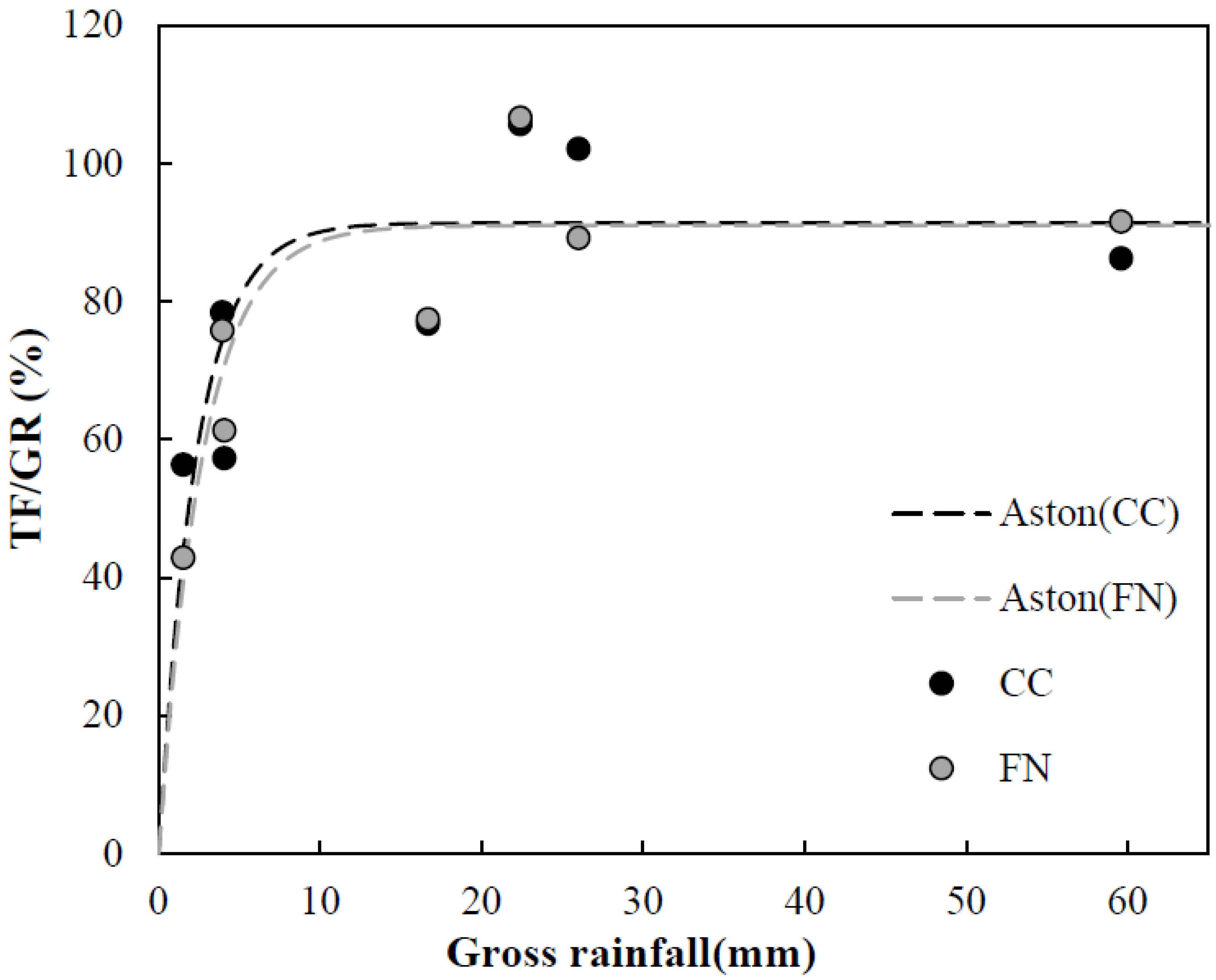
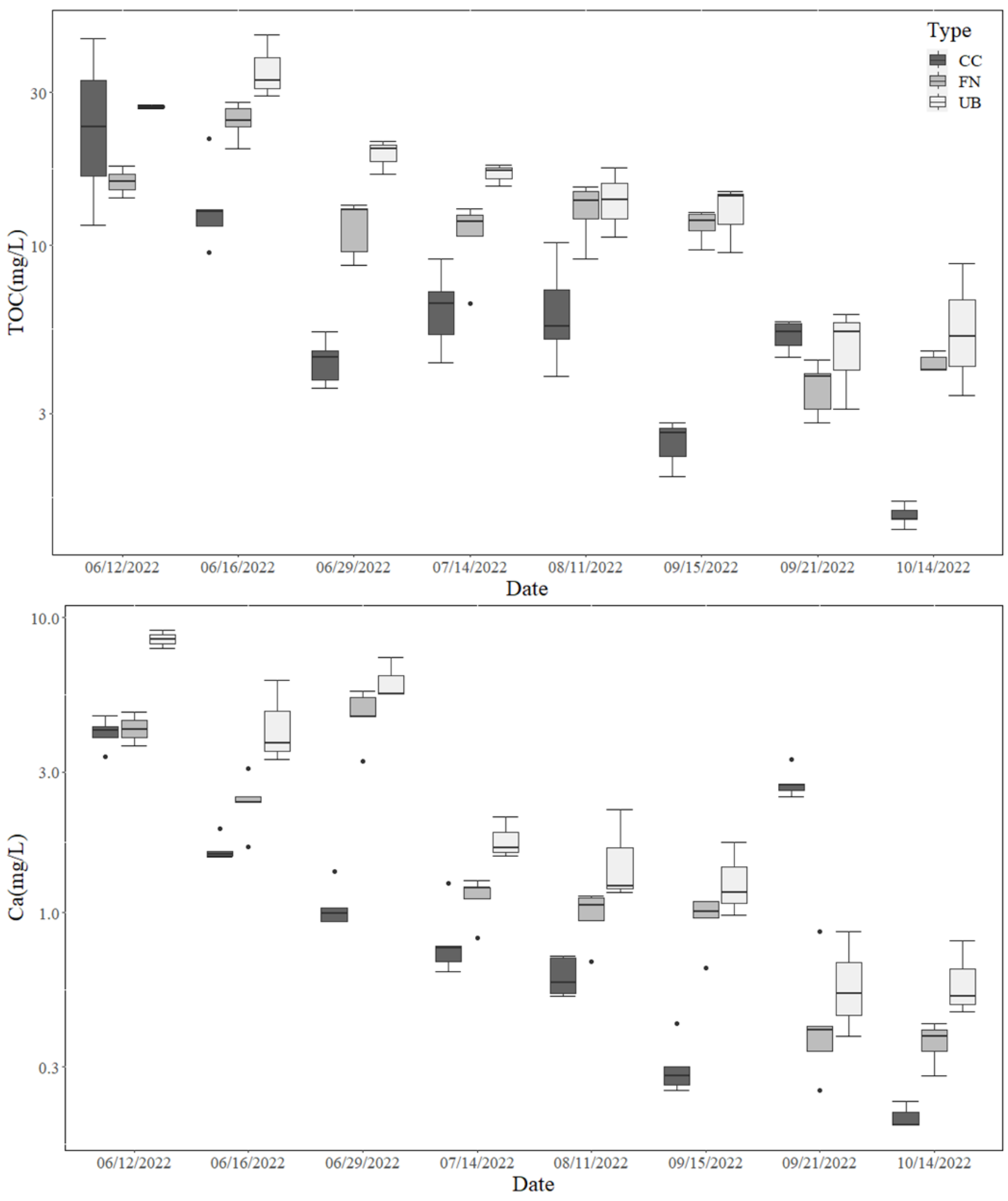


| Site | FN | CC | UB |
|---|---|---|---|
| Age class | VI | VI | VI |
| Stand density * (tree/ha) | 875 | 1275 | 425 |
| DBH (cm) | 37.2 ± 1.3 | 27.6 ± 2.6 | 50.8 ± 1.6 |
| Basal * area (m2/ha) | 63.9 ± 14.6 | 40.3 ± 6.7 | 86.3 ± 5.4 |
| Tree height (m) | 17.3 ± 2.2 | 11.7 ± 1.6 | 23.7 ± 3.6 |
| Canopy base height (m) | 9.5 ± 0.9 | 5.2 ± 1.5 | 11.7 ± 3.5 |
| Canopy cover (%) | 65.5 ± 5.8 | 43.0 ± 4.1 | 79.8 ± 4.4 |
| Major axis of the crown (m) | 9.7 ± 1.4 | 6.9 ± 2.3 | 7.3 ± 1.6 |
| Minor axis of the crown (m) | 8.4 ± 1.8 | 6.3 ± 2.0 | 6.5 ± 0.5 |
| Gross Rainfall, GR (mm) | Throughfall, TF (mm) | Rainfall Loss (mm) | TF/GR (%) | |||||||
|---|---|---|---|---|---|---|---|---|---|---|
| n = 7 | CC | FN | UB | CC | FN | UB | CC | FN | UB | |
| Mean (±S.E.) | 19.18 (±20.28) | 17.31 (±17.35) | 13.84 (±14.07) | 19.87 (±16.85) | 2.86 (±3.35) | 2.28 (±1.89) | 5.07 (±3.45) | 80.43 (±23.01) | 76.96 (±23.60) | 70.11 (±21.30) |
| Minimum | 1.50 | 0.16 | 0.19 | 0.35 | 0.03 | 0.02 | 0.06 | 10.41 | 12.50 | 8.87 |
| Maximum | 59.60 | 63.66 | 58.19 | 57.10 | 17.93 | 11.85 | 20.99 | 150.34 | 138.27 | 99.78 |
| Item | Site | Depletion Curve | Residual Standard Error |
|---|---|---|---|
| TOC | CC | 2.709 | |
| FN | 4.368 | ||
| Ca2+ | CC | 0.527 | |
| FN | 0.8945 |
Disclaimer/Publisher’s Note: The statements, opinions and data contained in all publications are solely those of the individual author(s) and contributor(s) and not of MDPI and/or the editor(s). MDPI and/or the editor(s) disclaim responsibility for any injury to people or property resulting from any ideas, methods, instructions or products referred to in the content. |
© 2023 by the authors. Licensee MDPI, Basel, Switzerland. This article is an open access article distributed under the terms and conditions of the Creative Commons Attribution (CC BY) license (https://creativecommons.org/licenses/by/4.0/).
Share and Cite
Kim, T.; Kim, Y.; Lee, J.; Woo, C.; Im, S. Post-Fire Changes in Canopy Solute Leaching in Pinus densiflora Forests. Forests 2023, 14, 1996. https://doi.org/10.3390/f14101996
Kim T, Kim Y, Lee J, Woo C, Im S. Post-Fire Changes in Canopy Solute Leaching in Pinus densiflora Forests. Forests. 2023; 14(10):1996. https://doi.org/10.3390/f14101996
Chicago/Turabian StyleKim, Taehyun, Yugyeong Kim, Jeman Lee, Choongshik Woo, and Sangjun Im. 2023. "Post-Fire Changes in Canopy Solute Leaching in Pinus densiflora Forests" Forests 14, no. 10: 1996. https://doi.org/10.3390/f14101996






